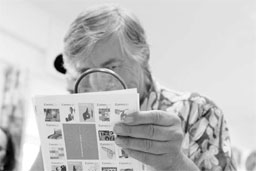Chapter 2: Our Customers
Stamps
Working closely with three authorized stamp manufacturers, an unprecedented variety of stamps related to the price change were available prior to the May 12 implementation date through all retail channels, including Post Offices, usps.com, and other alternative customer access points. Price change stamps included the denominated versions of the postcard price, the First-Class Mail flag stamp, 2-ounce and 3-ounce letter price stamps, and all postal stationery.
Stamp Fulfillment Services, located in Kansas City, MO, continued to provide a convenient channel for customers to purchase stamps and philatelic products. In 2008, 3.4 million orders were received by telephone, through the mail, and online at usps.com. Total revenue through this channel increased 9 percent.
Of the 37 billion stamps, stamped envelopes, and stamped cards produced this year, 7.8 percent were part of the commemorative program. A wide variety of exciting commemorative stamps were issued in 2008 including tributes to four great American Scientists, Black Heritage inductee Charles Chesnutt, the Lunar New Year series, and beloved author Marjorie Kinnan Rawlings. In May, Frank Sinatra headlined the program with a new 42-cent stamp. Flags of Our Nation, a new three-year series designed to stimulate interest in stamp collecting, was introduced on Flag Day. Sixty stamps displaying the flags of all states, territories, and the District of Columbia will be issued in a coil format through 2010.
Additional stamps honored the 100th anniversary of the popular song “Take Me Out to the Ball Game,” the design talents of Ray and Charles Eames, the sounds of Latin Jazz, actress Bette Davis, movies of the Vintage Black Cinema era, noteworthy American Journalists, the 2008 Olympic Games, and classic cars of the 1950’s featuring tail fins and chrome. The social awareness stamp for 2008 focuses attention on Alzheimer’s, a disease that impacts the lives of 5 million Americans and their families.

Stamp collector Richard Jansen takes a closer look at the Charles and Ray Eames stamps following the First Day of Issue ceremony in Santa Monica, California.
The fifth and final edition of the Art of Disney series was issued on August 7. All of the previously issued Art of Disney stamp panes have landed on the top 15 list of most collectable stamps since 1988.
Ideas for many of these stamps came from the American public. Each year 50,000 ideas are submitted for consideration by the Citizens’ Stamp Advisory Committee, a cross section of designers, historians, and educators, to narrow the selection of stamp subjects issued. The Committee reviews the suggestions and makes recommendations to the Postmaster General for final approval. The time between submitting a stamp idea and issuing the stamp can take several years. Additional information can be found at usps.com/communications/organization/csac.htm.
In addition to using stamps to commemorate people, events, and places, the Postal Service also issues stamps to fund causes as mandated by Congress. The Postal Service currently has one 55-cent fundraising or semipostal stamp available for purchase: the Breast Cancer Research stamp. Since its release in 1998, the Postal Service has sold more than 835 million stamps and raised more than $64 million for breast cancer research. The price of a semipostal stamp pays for the First-Class Mail single-piece postage price in effect at the time of purchase, plus an amount to fund the cause. By law, 70 percent of the net amount raised is given to the National Institutes of Health and 30 percent is given to the Medical Research Program at the Department of Defense.
Market Research
To evaluate and respond to changing customer needs, the Postal Service conducted several market research studies.
Small Business Technology and the Mail: This study shows that mail still plays an important role in today’s “wired” world even though the Internet has become an important tool for many small businesses. Mail is still valued more strongly than the Internet for privacy and security, whereas the Internet is valued for speed and cost. Although both channels are considered reliable, the study indicates that small businesses increasingly prefer online communications. In the face of these changing preferences, the Postal Service is exploring ways to leverage mail as a complement to the Internet to keep it relevant and important for small businesses. Several external studies have shown that mail adds value to campaigns that use other advertising and marketing media. Mail also complements online methods and improves campaign results.
CEO of the Mail and Technology Adoption: First started in 2004, this study shows that attitudes toward mail and the Internet remain relatively stable across generations. “CEOs of the Mail” — the persons most responsible for handling and using mail in a household — still prefer to receive promotional information about products and services through mail rather than email. The most recent research, however, reveals a strengthening of attitudes toward the Internet across various dimensions. Relevance of mail appears to be an issue with Gen Y consumers although they enjoy and use mail.